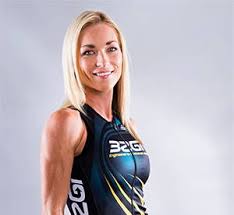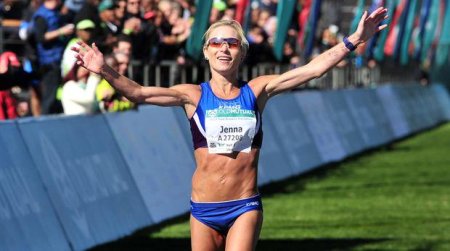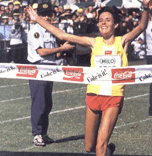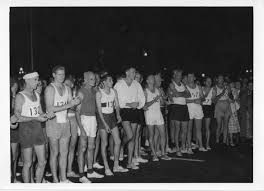“Dad I’m ready. Watch me from above. Watch me from up there”.
 COMRADES STARTLINE 2019 AS JENNA LOOKS UPWARDS
COMRADES STARTLINE 2019 AS JENNA LOOKS UPWARDS
These are the dramatic words spoken by Jenna Challenor seconds before the start of the 2019 Comrades and a moment captured in this photograph.
Always a self-confessed “Daddy’s Girl” Jenna lost her father tragically late last year and as he was her hero, she looked up to the skies on Comrades morning and said these words with a smile on her face.
She certainly was ready and first time out at Comrades, Jenna took home the gold medal for finishing in 6th place on the 10th of June 2019.
I had the chance to sit with Jenna and to try to find out a little bit more about her.
 Jenna Challenor
Jenna Challenor
DJ: Are you a Durban girl born and bred?
JC: Yes. Born and bred, I love Durban and have lived here my whole life. I was very privileged to go to Durban Girls’ College and had the absolute best time at school. I’d go back there any day 😉 and am so grateful to my Dad for all he did to send me to this prestigious school. I actually had my 20 year school reunion there a few weeks ago and – wow – since I was there, there has been a lot of development and I must admit I felt a little hard done by – hahaha! They have an amazing new aquatic centre, a beautiful gym above it, and a full size astro turf to name a few upgrades. We had awesome facilities back then too and were very spoilt but nothing like the facilities there now.
DJ: Were you involved in a lot of sporting activities when you were at school or did that only come later?
JC: I was a sporting all-rounder at school and having two older brothers with whom I had to keep up, made me very competitive. I did everything they did, from judo to gymnastics, ballet, swimming, hockey, running, you name it I did it. I was even put in a bin and used as their cricket wickets often and I was just happy to be involved- haha! I was competitive on the beach in life saving. I loved it, it was the absolute best way to grow up in Durban, learning about the ocean, whilst doing sport with your friends, on the beach.
DJ: Am I getting it wrong but didn’t you represent South Africa at lifesaving?
JC: Yes, I did lifesaving “nippers” when I was young and then juniors and seniors. I represented Durban Surf at World Champs in 1998 in New Zealand and that’s when I met my husband, we were in the same team (lucky me). I was 16 then and Durban Surf won the World Champs that year. When I was growing up I regarded myself more as sporting all-rounder. I played provincial hockey, I ran provincially at both athletics and cross country but I never focussed on one sport. I was in the swimming team too, did some diving, and a little netball too. I never had a coach for running so I just did what I thought should be done and ran on fitness I got from other sports. A coach only came much later in life.
DJ: With all these sports there must have been one that you preferred above the others
JC: It was definitely running but I did also loved hockey. In KZN there’s not a lot of opportunity for track athletics so it was cross country mainly. My passion was definitely there, I wasn’t a track athlete.
I was also very fortunate that my parents never put any pressure on me or tried to push me in one direction. They were supportive and happy for me to do whatever sports I wanted to do and I think that with two older brothers, I learnt to push myself hard to keep up. I thank them for never being easy on me and for their torturous ways – they made me tough.
DJ: A question you perhaps won’t like, but with all your sporting success, how was the classroom and results there.
JC: I was by no means super academic but I did alright in the classroom. I was never an academic or “A” student but I worked hard and had pleasing results as a “B” student and I was happy with that.
DJ: After school you went and studied to become a teacher didn’t you?
JC: Yes, I got a B.Ed foundation phase degree. I was offered a scholarship to go and run in America when I was in matric but I wasn’t sure that I wanted to make running my life so we didn’t pursue that and I decided that I would rather stay here and study and see what lay ahead. I did the usual varsity thing. After school, I didn’t concentrate too much on running. I did a bit of social running and I took a break from competitive running. It was only after the birth of my first daughter that I decided to get back into competitive running.
DJ: You must have taken a break from running during your pregnancies?
JC: NO, actually not. I ran during all of my pregnancies right up to the day I was in labour, although I was VERY careful using a heart rate monitor and I didn’t race. My soul focus was a healthy baby and just keeping sane with a bit of running. A funny story; When I went into labour and went to hospital for the birth of my first daughter I wasn’t quite ready so the doctor said I should walk around the parking lot. My immediate reaction was “Oh! You are kidding me” so I went down to North Beach and ran 7kms along the promenade and then went back to the hospital in the hopes that the run would speed things up! It didn’t, 36 hours of labour and eventually an emergency C-section, but I got a beautiful healthy baby girl. The best day of my life.
DJ: So how long were you out of running whilst all the babies were arriving?
JC: I absolutely loved the “new born” stage with my children and didn’t rush that stage to run. They grow up so fast. I got back into running after, Nicolette, my first baby, only to decide 15 months later that I wanted another one. After Rylee, my second, I started running seriously again and I think this is where I was noticed for the first time since school. 15 months later I did want another baby, but my husband was hearing none of it, hence the big gap to my third, Tao. I had to beg for her for 4 years but I did get my way eventually – hehe! One positive, the big gap did give me more time to get my competitive running established.
DJ: In the middle of all this sport there was also a period of photography. Tell me about that.
JC: When I was teaching I started photography as a hobby at the pre-school where my kids were. It was mainly self-taught with some professional guidance from Brett Florence. My focus was family photography and new-born shoots and I built a photographic studio at home. Teaching, photography, running and two children became too much so I decided to resign from teaching and do my photography which gave me the flexibility to run more and make sure I was there for my children.
 THE VERY CLOSE CHALLENOR FAMILY ON THE TRACK
THE VERY CLOSE CHALLENOR FAMILY ON THE TRACK
DJ: How long have you been a professional runner?
JC: Well, I guess with working I was considered a semi-professional runner but I would say it was after my third daughter was born in 2012. She is 7 now so I have been a professional athlete for 7 years. Soon after she was born I was back into my running seriously and the time was right to start running professionally.
DJ: So you were over 30 when you started running professionally. That’s a bit late isn’t it?
JC: Well yes, before that I was semi- professional as I was still teaching and doing photography. With three births it was a bit stop-start. After my third in 2012, it was “babies done, time to run” and I really put my head down and decided I wanted to give it a full go and that’s when I guess I turned pro. I tended to do things the other way round in life. I had my daughters very young and now I’m running professionally. It is a juggling act as a mum but it’s also so awesome because I am a young mom and they are now able to train with me and share in my passion, they are my biggest fans along with my incredible husband who dreams my dreams as big as I do. He is the reason I am able to run as a mom of three children.
A huge part of what inspires me to run now, is the ability to inspire women, especially moms, to do things for themselves and to show them that sport doesn’t have to stop after having children. If I can do it with 3 children so can they, I believe a little ME time doing what I love makes me a better mom.
DJ: With everything you’re involved in, where do you find the time for your own training?
JC: Where there is a will there is always a way, everyone has their things. I train around my children. My first session is always at 4:30 in the morning. I then get the girls ready for school, drop them off and go to my second session, well – after a cup of coffee of course! That’s about 2 hours. I start fetching children at 12.30. Tao is first then we go to her extra murals (either gymnastics, ballet or swimming). At 2pm I fetch the other two from school , take them home to eat lunch then I will drop them wherever they need to be (running, hockey, swimming ,matches etc.) and I will do my third session while they train, before I fetch them again. It works but I have a strict schedule and can’t fit much more into my day and by 7pm I am shattered. My husband helps a lot and my mom in law where she can, so I am very blessed.
DJ: From the point of view of your own running, do you coach yourself or do you have a coach?
JC: Yes I do have a coach but he prefers to be low key, all the same I’m honoured to call Ernie Gruhn my coach, my friend and a person who believes in me and pushes me to be the best that I can be. He is a very special person to me and my family.
 Jenna with her coach Ernie Gruhn
Jenna with her coach Ernie Gruhn
I started training with Ernie just before World Half marathon champs in 2014 and it was one of the best decisions of my running career. He has taught me the value of consistency and has given me belief in my abilities and myself.
DJ: I’ve read someplace that a lot of your Comrades inspiration has come from Bruce Fordyce with encouragement from him.
 Bruce Fordyce and Jenna
Bruce Fordyce and Jenna
JC: Yes, Bruce is a really good friend and I have had a lot of encouragement from him. He has nagged me to run Comrades for many years but I didn’t really know when the right time was so I worked my way up through the distances until a started looking at ultras. I also only ran my first marathon in 2014 when my last born daughter turned two. I have run 5 marathons in total and raced 3.
I still run so passionately and competitively because I believe our children are influenced by what they are exposed to and I want to show my children life through sport, how amazing it is and to teach them to be grateful for their health and mobility and never to take it for granted. I always tell them that sport takes you places, opens doors, creates opportunities and makes you so many friends.
My girls have already experienced doors opening through sport with their sports bursaries to Epworth High School in Pietermaritzburg, a school we simply couldn’t afford to send them to without the bursaries and that is credit to them and what they have put into their sports. I also want them to do ALL sports right now and to choose the sports they like the most and not just run because I do.
Of my three daughters, it’s the middle one who is absolutely besotted with running, she’s is 12 now and doing very nicely but I follow a LESS IS MORE philosophy with her while she is so young. My oldest also loves sport, she is a very good swimmer and her passion is surf life-saving like her dad. They both also enjoy hockey, paddling, biathlon and triathlon. Rylee wants to be a professional athlete like mom one day, Nix says she definitely doesn’t want to, it’s far too much hard work – classic, I love their honesty.
Sport definitely has the power to change people- I love how, in a race or on a run no matter what religion or race we are, we are all equal, all friends, supporting each other doing what we love with so much passion.
DJ: Apart from people like Bruce has any other runner inspired you?
JC: Yes. Without doubt it’s been Helen Lucre, she helped me a bit when I was younger and I always loved hearing about her running and Comrades days. Sadly though I don’t think that Helen has had as much recognition as she perhaps should have had. The trouble is that people don’t seem to know much about Helen because of the fact that she was at the top in the mid-1980s when road running and even Comrades didn’t have the exposure it has today. She was a really good runner and a very humble athlete who won Comrades three years in a row as well as many other races.
DJ: Over the last couple of years you have emerged as a better than average ultra-distance runner and it was probably in Two Oceans in 2017 that people first started to take notice of you as an ultra-runner when you finished 2nd.
 Jenna takes 2nd place at 2017 Two Oceans
Jenna takes 2nd place at 2017 Two Oceans
JC: It’s definitely the longer races that I’m enjoying now. I feel like I’ve waited my whole life to run ultras, I couldn’t do it when my daughters were younger, I felt it wasn’t fair on them or me but they are older now so now I can.
All I wanted from Comrades this year was to simply love it and I did just that. I loved every step of the way – ok, except perhaps the last 2kms which were hard. I love running so much, to me it’s more than just winning. If I run a race and finish 4th/5th or 6th like I did at Comrades this year, but I enjoy it, have fun and feel good, it’s a win for me and it’s the reason I RUN. Comrades was next level, I LOVED the crowds, they were ABSOLUTELY awesome and it’s an incredible feeling to race in my hometown. I literally smiled and waved to friends from start to finish.
 Jenna comes home 6th in COMRADES 2019. Note the rose she’s holding
Jenna comes home 6th in COMRADES 2019. Note the rose she’s holding
DJ: Tell me about the Olympics. A few years ago you qualified to run the Olympic Marathon but injury stopped that from happening and now the rules have been changed in terms of the times you would need to run to qualify. Right now, you’re about 7 minutes short of the new qualifying time. Are those 7 minutes too big an ask now?
JC: It’s every athlete’s dream to run the Olympics and I was really sad that I didn’t have the opportunity to run in the Olympics because realistically it’s probably the only opportunity I would have had. I dream big but I’m not unrealistic, if Olympics came to me I would take it with open hands but I’m not focussing only on Tokyo next year, and to be honest, I think it’s just too far for me to take 7 minutes off my time and I feel at my age its too late to focus on marathons now.
DJ: Is there going to be a big focus on Comrades next year. Are you planning to run again?
JC: I don’t think I’m going to change what I’ve been doing. I’ve been having so much fun and I’m just so grateful to be running again after my stress fracture don’t think I’m going to change what I’ve been doing. I’m just so grateful to be running again after my stress fracture last year and yes I’d love to try the Down Run. It’s a totally different race being a Down Run and longer than the Up Run but I definitely want to line up for it, all going well. It’s a long way away still. I don’t want all my eggs in one basket. I will race other races too.
That then is Jenna Challenor. Wife, mother and runner and 6th in Comrades and a gold medal in her first Comrades run in 2019 and a gold medal in both 2017 and 2019 at Two Oceans.
I think we can expect more medals in that gold colour from this lady!
******************************************
A FINAL WORD by Jenna
A little girl. A big dream. A COMRADES ROSE 
For as long as I can remember I have said I WILL RUN Comrades and I will get that red rose (given to the first 10 men and first 10 women just before the finish line). The day before a race Brett often gets me roses, this time he arrived home and said “I didn’t buy you roses, go out and get your own tomorrow!
10 September 2019


 Bruce Fordyce in one of his 9 wins
Bruce Fordyce in one of his 9 wins Jackie Mekler wearing his famous race number 9
Jackie Mekler wearing his famous race number 9
 Coming in to finish my first Comrades in 10:25. Alone on the track!
Coming in to finish my first Comrades in 10:25. Alone on the track!
 COMRADES STARTLINE 2019 AS JENNA LOOKS UPWARDS
COMRADES STARTLINE 2019 AS JENNA LOOKS UPWARDS









 BETTY CAVANAGH FINISHING IN 1975
BETTY CAVANAGH FINISHING IN 1975 LETTIE VAN ZYL – winner 1976-1978
LETTIE VAN ZYL – winner 1976-1978 ISAVEL ROCHE-KELLY
ISAVEL ROCHE-KELLY CHERYL WINN COMING IN TO WIN 1982
CHERYL WINN COMING IN TO WIN 1982  LINDSEY WEIGHT WINNING 1984
LINDSEY WEIGHT WINNING 1984 FRITH VAN DER MERWE AFTER HER 1989 WIN
FRITH VAN DER MERWE AFTER HER 1989 WIN THE NURGALIEVA TWINS
THE NURGALIEVA TWINS CAROLINE WOSTMANN – WINNER IN 2015
CAROLINE WOSTMANN – WINNER IN 2015 CHARNE BOSMAN – 2016 WINNER
CHARNE BOSMAN – 2016 WINNER CAMILLE HERON – 2017 WINNER
CAMILLE HERON – 2017 WINNER ANN ASHWORTH NEARING THE FINISH IN 2018
ANN ASHWORTH NEARING THE FINISH IN 2018 GERDA STEYN WINNING COMRADES 2019 IN UNDER 6 HOURS
GERDA STEYN WINNING COMRADES 2019 IN UNDER 6 HOURS BAGSHAW COMING IN TO THE FINISH OF THE 1969 COMRADES
BAGSHAW COMING IN TO THE FINISH OF THE 1969 COMRADES DAVE BAGSHAW, BRUCE FORDYCE & ALAN ROBB, 3 OF THE 5 RUNNERS TO ACHIEVE A HAT TRICK OF WINS
DAVE BAGSHAW, BRUCE FORDYCE & ALAN ROBB, 3 OF THE 5 RUNNERS TO ACHIEVE A HAT TRICK OF WINS DAVE BAGSHAW WITH HIS FAMILIAR RUNNING ACTION DURING COMRADES
DAVE BAGSHAW WITH HIS FAMILIAR RUNNING ACTION DURING COMRADES WITH HIS SECOND DURING COMRADES
WITH HIS SECOND DURING COMRADES COMING HOME TO WIN THE 1971 COMRADES
COMING HOME TO WIN THE 1971 COMRADES
















